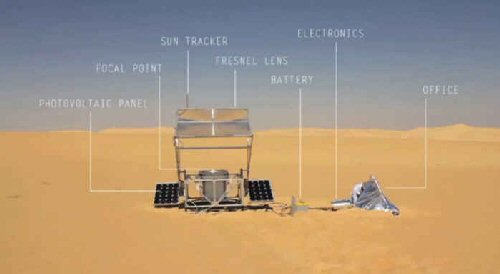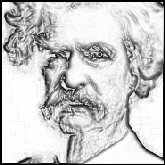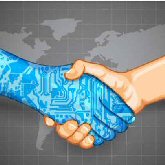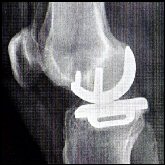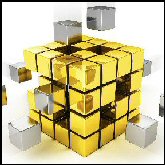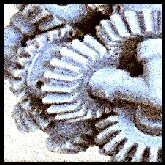What happens when, instead of manufacturing a product with cheap labor overseas, you can select a design from the internet and download it the same way you purchase music and then create the product at the point of sale? Good-bye supply chain. Hello customization.
Sound like sci-fi to you? Well, you can do it right now. Some say it’s the next industrial revolution and the structural changes it promises are staggering.
- No factory
- No warehouse
- No shipping
That’s the future promised by 3D printing.
I’m at the MIT Enterprise Forum’s 3D Printing event, listening to Mike Vasquez PhD of 3D PRINTING REPORTS and Julie Friedman Steele of THE 3D PRINTER EXPERIENCE, both right here in Chicago. Julie’s the gal who’s writing the Encyclopaedia Britannica section on the subject. And yes, you can go to her place and experience it for yourself.
I’ll brief you on the whole thing, then show some videos for those who want to dig deeper.
.
What’s Different About It?
The idea of printing rather than machining a bolt or a gear may seem counterintuitive. We’re accustomed to the SUBTRACTIVE process—starting with a block of material and whittling it down to the desired shape. 3D printing is ADDITIVE. Layer upon layer is added till the product is built up to its full shape. Almost no waste. Complexity is free. Users enjoy huge amounts of geometric freedom and can build designs once thought impossible.
For example, here’s a drawing of three gears that can’t move in the real world. They bind each other. The design is just as impossible as the slogan printed on the graphic.
.
In contrast, the Triple Gear is printed in one piece and actually moves as a unit—something entirely impossible in the recent past. A video on this design is posted below.
Prototyping is where the industry got its start because it’s such a simple way to create complex one-of-a-kind machines. You design your product using software then print it like a letter off a word processor. But instead of paper and ink, 3D printers work with materials from plastics to ceramics to bronze, copper, gold, and stainless steel alloys, to human biological tissue.
Hospitals use the printers to create titanium hip replacements. Bio-printing is another exciting prospect—printing with human cells that the body won’t reject. One burn victim received a new ear copied and inverted from the other side. Cartilage can be built—dental implants are already routinely made.
There’s even a competition to print edible meat.
.
Who Uses it Now?
NASA, GE, Boing, Ford, BMW, Caterpillar, Nike, and Reebok are all working with this technology.
Burton Snowboard invented the winter alternative to skiing in the ‘70s. Now they constantly improve their products using 3D printing. Under the old design standard, prototypes cost tens of thousands of dollars and took months to complete. Using 3D printers, the process goes from months to days. They iterate prototypes the way they used to iterate sketches. They print out products and test them under actual conditions.
Early adopters are already bringing 3D printers into their homes. Even the Chicago Public Library boasts one. But according to Steele, if you want to operate one, you’d better be capable of building one. “This is a robot with a lot of moving parts that all need service…Unless you’re capable of building a printer, don’t own one…Low-end models melt plastic and that causes bad things in the air—similar to smoking plus hydrogen cyanide…Filtration and a lot more research is needed.” The message is clear: Don’t try this at home—this is for professionals. But don’t despair. Steele suggests that you bring your project to a service provider that keeps up their own printers and takes jobs on contract. Dozens of these exist in Illinois alone.
3D is huge for restoration. Jay Leno, prints hard-to-find parts for his antique cars.
Tiffany and other jewelers are already using it to reduce inventory and create product. But it also brings fear to the industry. It’s now possible to design and produce wedding rings to the match each happy couple’s whim. How many jewelers can afford the equipment?
A high-end laser sintering machine can print within tolerances of 100 microns and produce stronger parts than traditional manufacturing. Such machines cost from $250K to over $1M. Low-end machines can be had for under $5K but their utility is nowhere near the high-end equipment. There’s an active government initiative to create an invent space with less expensive machines.
.
Who Knows the Technology?
According to Steele, “By and large, the general public knows nothing about it. You actually have to make something to understand the process. The purpose of THE 3D PRINTER EXPERIENCE is education. That’s how to get mass adoption. Education is the least profitable but the most important.”
During his talk, Dr. Vasquez shows a video of Markus Kayser, an artist who built his own 3D printer for a few thousand dollars. In the Egyptian desert, he used the sun and a huge Fresnel lens in place of a laser. For material, he took what he found—the plentiful and entirely free sand of the desert. Kayser’s video is posted below as well as his talk at TEDx.
.
The Hackers
One of the great things about the MIT Enterprise Forum is the chance to meet extraordinary people. It turns out that a thriving community exists just for the love of creation—creation of the complex products only possible with 3D printers. These are the hackers. Hackers are the early adopters.
I talked at length with Keith Earl Weber II of DRAGON R&D. He uses 3D printers for research and his company takes in jobs. This could be a way to get your project off the ground.
I came across a video that demonstrates the practical potential of this technology with great clarity. It’s from an individual that goes by the internet handle of Barnacules Nerdgasm, but don’t let that deter you. His video is posted below.
So, are you ready for a 3D world? Check out The 3D Printer Experience and find out.
.
Contacts
Julie Friedman Steele on Wikipedia
Julie@The3dPrinterExperience.com
.
.
Contact Keith Earl Weber II – Kewiiq2@gmail.com
.
.
Video
THE 3D PRINTER EXPERIENCE
Our speaker, Julie Friedman-Steele
.
BARNACULES NERDGASM
A hacker prints a transmission.
.
HENRY SEGERMAN
First example of a triple gear, as shown at tonight’s event.
.
MARKUS KAYSER
Homemade printer using the sun and sand to create products, as shown at event.
.
MARKUS KAYSER AT TEDx
.
Photo credits – You Tube, The 3D Printer Experience, 3D Printing Reports, Julie Friedman Steele, Mike Vasquez PhD, Markus Kayser, Henry Segerman, Barnacules Nerdgasm,
Chicago Venture Magazine is a publication of Nathaniel Press www.ChicagoVentureMagazine.com Comments and re-posts in full or in part are welcomed and encouraged if accompanied by attribution and a web link . This is not investment advice. We do not guarantee accuracy. It’s not our fault if you lose money.
.Copyright © 2013 John Jonelis – All Rights Reserved
.
.







